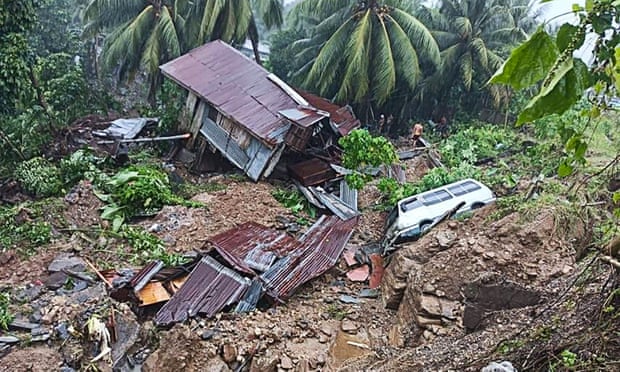
The Philippines has significantly revised down the death toll from a tropical storm ravaging the country, saying only 45 people have been killed.
The civil defence office had earlier reported 72 dead, 14 missing and 33 injured, but civil defence officials acknowledged rescue teams sent to the country’s flood-hit south on Friday had erred in their reporting, leading to some deaths being counted twice.
“When we consolidated the reports at 6am today we realised there were only 40 dead, 31 injured and 15 missing,” Naguib Sinarimbo, the spokesman and civil defence chief for the southern region, said on Saturday.
The national civil defence chief, Rafaelito Alejandro, confirmed the lower figure at a news conference in Manila, saying 40 bodies were recovered from the disaster in the southern region of Mindanao. Five other people had been killed elsewhere in the country, Alejandro added.
Tropical Storm Nalgae hit the country’s main island of Luzon with maximum winds of 95km/h (59mph) after making landfall on the sparsely populated Catanduanes island before dawn.
Heavy rains triggered by the approaching storm began on Thursday in the southern Philippines, the state weather service said, inundating mostly rural areas on Mindanao island.
That was followed by landslides and flooding, with fast-moving, debris-laden waters sweeping away entire families in some areas and damaging nearly 500 houses.
In recent years, flash floods with mud and debris from largely deforested mountainsides have been among the deadliest hazards posed by typhoons in the Philippines.

Rescuers are focusing on the village of Kusiong, where several bodies were recovered on Friday after the floods hit.
Flooding was also reported in several areas of the central Philippines. No deaths were reported there.
Photos released by the coastguard showed rescuers using an old refrigerator as an improvised boat to pull children from a flooded community on the central island of Leyte.
The state weather service said Nalgae could hit the capital, Manila, a sprawling metropolis of more than 13 million people, bringing “intense, with at times torrential, rains”.
“Widespread flooding and rain-induced landslides are expected” while there was “minimal to moderate risk of storm surge” or huge waves hitting coastal areas, it added.
“Based on our projections, this one is really strong, so we really prepared for it,” Alejandro said, adding that 5,000 rescue teams were on standby.
He urged residents in the storm’s path to stay at home until the storm passed into the South China Sea early on Sunday.
“If it’s not necessary or important, we should avoid going out today because it is dangerous and could bring you harm,” Alejandro said.
More than 7,000 people were evacuated before the storm’s landfall, the civil defence office said.
The coastguard has also suspended ferry services through most of the archipelago nation due to rough seas, stranding hundreds of vessels and thousands of passengers at ports.
The civil aviation office said it has cancelled more than 100 flights so far.
The storm struck at the beginning of a long weekend in the Philippines, when millions return to their home towns to visit the graves of their relatives.
The Philippines is hit by an average of 20 major storms a year that kill hundreds of people and keep vast regions in perpetual poverty.
Scientists have warned that such storms, which also kill livestock and destroy key infrastructure, are becoming more powerful as the world gets warmer because of climate change.